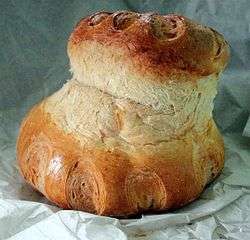Cottage loaf
|
A small cottage loaf baked in a traditional bakery in Rochester, Kent | |
| Type | Bread |
|---|---|
| Place of origin | England |
|
| |
Cottage loaves are a traditional type of bread originating in England.
A cottage loaf is characterised by its shape, which is essentially that of two round loaves, one on top of the other, with the upper one being rather smaller: the shape is similar to that of the French brioche and the pain chapeau of Finistère.[1]
The origins of the name and shape are unknown but possibly extend back hundreds of years.[2] Elizabeth David, who described the cottage loaf in her English Bread and Yeast Cookery, surmised that the shape may have arisen as a way of saving 'floor space' in old-fashioned bread ovens.[1] The name, however, did not first appear in writing until the mid 19th century.[3] It was formerly possible to find an oblong version, known as a "cottage brick", and common in the London area.[3]
Cottage loaves, while formerly common, are now rarely found in bakeries, as they are relatively time-consuming and difficult to make, and in common with other round loaves are less convenient for slicing.
See also
References
External links
- "English Cottage Loaf". Chef2Chef. Archived from the original on September 28, 2007.
- "Bread Making Demonstration—Basic Bread: Cottage Loaf". Chef Taylor Piercefield & RecipeTips.com.
